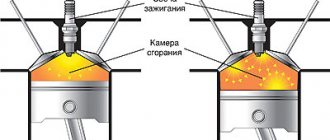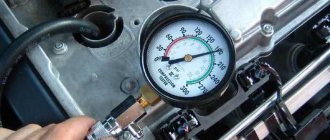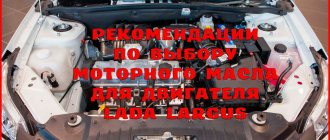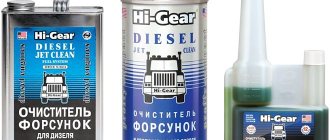Increasing turbine power.
Where does the increase in turbine power come from? What is the power formula for any engine, and how does the turbine affect this formula? (Don't be scared to death by the formulas; the ones discussed below are simple and easy to understand.) To answer these questions, you need to study the linear equation in one unknown that relates power to the parameters that describe the engine's internal combustion.
Power = P*L*A*N
P is the average total pressure in the cylinder. It is easier to think of P as the average pressure acting on the piston.
L - stroke length. It tells you how far the piston will move under this pressure.
A is the cross-sectional area of the cylinder. Here it is, the same area to which pressure is applied.
N is the number of engine strokes in one minute. This number shows how many cylinders the engine has and what its speed is.
N = number of cylinders * engine speed/2 (For a four-stroke engine, the speed is divided by 2 because each cylinder makes a power stroke once every two revolutions)
There are some interesting dependencies here! For example, take P and multiply by A and you have the product of pressure and area, which is the average force acting on the piston. Now multiply P*A (force) by stroke length L (distance) and you have a number that represents torque, now take that number and multiply it by N (how fast the work is done) and you get power (that is, which is what we ordered). Please note what this means: power = torque * rpm.
Since the overall goal of our exercise is to gain more power, let's explore what " P*L*A*N " allows us to work on. First let's look at what working with N . There are two ways to get more power strokes per minute: increase the number of cylinders or spin the engine to higher speeds. This gives some scope for effort: the efforts of an entire field of human activity known as engine design are aimed solely at achieving higher revolutions per minute with a certain margin of safety.
Remember that the hated inertial loads increase quadratically with increasing engine speed. This means that at 7200 rpm, the inertial load will deliver 144% of the load encountered at 6000 rpm. The engine is subject to increased wear and destruction. Ultimately, increasing power output by increasing N is neither cheap nor pleasant and does not contribute to achieving a long service life. Since we are not, for the practical reasons stated above, looking to significantly increase power by increasing N , the only remaining choice is to increase torque by doing something with P*L*A . We need to go back and look at P*L*A a little more closely.
Let's try to change A , that is, the cross-sectional area of the cylinder. How much will this help? Change the cylinder bore by 3mm and you might get a 10% increase in power. Don't bother. We can also change L , the stroke of the piston. Maybe we'll get somewhere around 10%. Obviously, if our goal is to significantly increase power, then A and L won't give us much.
Changing P becomes our only hope. How to successfully change P is a complex issue. P can be changed by a factor of 1.2,1.5,2,3,4, 5... the real potential is unknown, as engineers are constantly groping for a new limit. The 1987 Grand Prix racing car took turbocharger development to the highest level ever achieved, bringing power output to almost 1 hp. per cubic centimeter. This is enough to say that doubling the power of our conventional engine is not a child’s fantasy, it is our justified expectations. What is especially important to note here is that we are significantly increasing power without increasing engine speed. Because the PLA is what we really change. The turbine increases torque, and torque is great!
Engine elasticity
What are the limitations imposed by a turbo engine on elasticity? Good elasticity and responsiveness to driver inputs are a must for most of today's cars. “I sat down, started it, and drove off.” If not, then the modern consumer is dissatisfied. It is generally accepted that high power and good elasticity are not compatible in one car. This opinion is quite fair for naturally aspirated engines, but is completely unsuitable for turbocharged engines. Let's look at the factors that determine elasticity: conservative camshaft profiles, small intake ports, flexibility and fuel system calibrations.
A proper turbocharged engine has a low overlap camshaft profile, commonly referred to as an "economy camshaft". The port sizes are usually small to ensure good filling of the cylinders at low speeds and allow the compressor to compact air into them when high pressure is required. Fuel system calibration must be accurate, at least for electronically controlled fuel injection. It is obvious that the factors that create good elasticity are present in cars with turbo engines. The fact that turbocharging allows more air to be supplied to the cylinders when necessary does not in the least affect the “sit down, start and drive.” However, there are two elasticity factors that come into play when turbocharging is used: boost threshold and lag. They, however, do not significantly degrade the performance of naturally aspirated engines, since the camshaft, compression ratio, ignition timing, and fuel mixture remain virtually the same.
A typical example of the difference in torque curves for a turbo engine and a naturally aspirated engine.
Service
The specifics of operating diesel engines imply scrupulous compliance with all manufacturer's requirements, any violation of which may ultimately lead to the need for expensive repairs. Recommendations common to all power plants of this type include:
- Timely replacement and quality control of oil.
Experts advise carrying out this procedure even more often than the service interval prescribed in the manual. This recommendation is due to the unstable sulfur characteristics of Russian diesel fuel. As a conditional interval, you can focus on a mileage of 7000 km? 7500 km. - Timely replacement of the timing belt.
In this case, it is recommended to follow the same principle as when changing the oil. For many engines, the permissible belt mileage reaches 100,000 km, but it must be taken into account that we are talking about practically sterile conditions, which are fundamentally unattainable on domestic roads. The breakage of a belt that has worn out prematurely always means destruction of the cylinder head, the repair or replacement of which costs a significant amount. - Monitoring the cleanliness of the fuel system.
It is recommended to replace the filter at least every 10,000 km, and to regularly drain the sediment that accumulates in the sump from the filter itself. It is advisable to wash the fuel tank twice a year, removing it from the car. Failure to comply with these requirements may result in failure of the injectors and fuel pump.
Boost threshold.
Boost Threshold, categorized as a term/for glossary, essentially means the lowest engine RPM at which the turbocharger can produce boost pressure (with the throttle wide open). Below these speeds, the turbocharger simply does not have enough exhaust gas energy to develop the compressor speed necessary to create above-atmospheric pressure in the intake manifold. Until the boost threshold speed is reached, the engine torque curve remains virtually the same as that of a naturally aspirated engine. If the engine is cranked further at full throttle, the driver will feel a significant increase in power past the boost threshold as the torque curve points upward. If the throttle is not fully open, the turbocharger will not contribute to the torque curve and acceleration will be the same as a naturally aspirated engine. The torque curve to the boost threshold can sometimes be a trade-off due to unnecessarily lowering the compression ratio (combustion chamber volume plus cylinder displacement divided by combustion chamber volume), causing an unpleasant unboosted feel at low rpm.
This is where it turns out that some of the car manufacturers made a serious engineering and economic mistake by not installing appropriate intercoolers to sufficiently cool the intake air. This would allow higher compression ratios to be used, providing crisp engine response at low speeds. If you're shopping for a car with a turbocharger, try asking the salesperson about the intercooler efficiency parameters (only after you've asked whether the car even has an intercooler, of course). It is reasonable to expect low speed elasticity to be pure if the vehicle is equipped with an intercooler and the compression ratio is 8 -10.
Judging the quality of a turbocharging system solely by the presence of a low boost threshold is a serious mistake. It's hard to prove that positive boost pressure at low engine speeds is a bad thing, but it's easy to argue that it's low-speed boost pressure achieved by a smaller turbo - a potential problem associated with higher exhaust backpressure. A carefully designed system, in which due attention is paid to all its parameters, will produce good boost pressure at low speeds, and this will only be a positive quality.
Diagram of torque increase when using small, medium, and large turbines installed on the same engine.
Small turbos often produce an irritating response at slight throttle openings. This no doubt affects the engine's elasticity, as small movements of the throttle produce a quick and usually unwanted surge in boost pressure that detracts from the smoothness of the car. This sometimes causes the passenger to think of the driver as nervous and unstable. This small surge often gives the driver hope that the car will actually fly when the throttle is wide open. Instead, he sadly observes that this splash was all the boost pressure, which could only depict a small “hole.”
Manufacturers do this every now and then, hoping that we will think that the car has instant response and torque throughout the entire rev range. They completely missed the fact that our main expectation is really high power. This mistake of manufacturers also has a downside - many journalists, writers, cool drivers, and other social outcasts ask in surprise - “Where the hell is the meat!?” » Production turbo engines are generally far from what enthusiasts and engineers would call perfect. Let us call production turbo engines conservative.
Method 4 – modernize the exhaust system
It doesn’t matter at all what size your engine is, 1.6 or 2.0, 16 or 8-valve unit, whether it has electronic or mechanical ignition, in any case, the gases leaving the engine encounter serious resistance in the exhaust system. By showing enthusiasm in the modernization process, we can significantly increase the power of the machine. There are several options:
- Increasing the diameter of the exhaust pipe;
- Increasing the intake manifold opening;
- Installation in a direct flow or straight pipe system;
- Reducing the length of inlet pipes;
- Installing a zero resistance filter.
Similar means can be used to increase the power of a diesel engine.
Delay.
A discussion of turbines is rarely complete without mention of lag (turbine lag). In fact, discussants rarely actually talk about delay. They usually talk about the boost threshold. Please read the definitions of lag, boost threshold, and throttle response in the glossary. When applied to a turbocharger, lag essentially means how long you have to wait for boost pressure after you open the throttle. Therefore, this phenomenon is not useful by definition. But the delay has nothing to do with throttle response. In this case, throttle response has the same meaning for both a turbo engine and a naturally aspirated one. The situation comes down to the following - either there is some delay and a huge increase in torque, or, on the contrary, there is no delay and no increase in torque. If you don't have any lag, you don't have any boost. Therefore you cannot expect any significant increase in torque. The delay decreases with increasing engine speed. While the lag can last a second or more at low engine speeds, as the boost increases, at about 4000 rpm or more the lag virtually disappears. For example, in a properly designed boost system, boost pressure will always follow your pedal position above 4000 rpm. The reaction here is virtually instantaneous.
The shape of the torque curve of a turbocharged engine is quite different from that of a naturally aspirated engine. On turbocharged engines, peak torque is virtually always at lower revs. Compare the characteristics of all known engines and you will come to exactly this conclusion. The more boosted a naturally aspirated engine is, the greater its difference from a turbocharged engine. The result for the driver is that he or she doesn't have to rev the turbocharged engine as hard to go faster. This logical conclusion is completely contrary to popular opinion, but the fact is obvious.
Comparison
delay values of small, medium, and large turbines.
Hot and cold starting are often presented as problems in highly boosted engines. To some extent this is true of turbocharging systems with carburetors, but such systems are few in number. Fuel injection systems rely solely on intelligent temperature sensor readings for cold and hot starts and are fully automatic. Cold starting is a problem for engines with lower compression ratios. If an engine has problems in this regard without a turbocharger, it will likely have the same problems with a turbocharger, since the supercharger has no effect on these temperatures or the electronics. In any case, this difficulty is not related to turbocharging.
Choosing fuel and oil for a diesel car
The key advantage of a diesel engine is its modest fuel consumption. Owners of such cars are required to monitor the quality of diesel fuel consumed by the car and check the condition of the filters. The point is this: the diesel power system is sensitive to the ingress of small particles, impurities and water. There is also the need to replace diesel fuel in accordance with the weather - refuel with diesel fuel for winter or summer according to the season.
Diesel fuel thickens at sub-zero air temperatures. The low quality of diesel fuel in the CIS countries, combined with frost, can make starting a diesel engine problematic. To avoid this problem, you should perform simple manipulations:
- Use special antigel additives;
- Monitor the performance of spark plugs and promptly replace failed elements with new ones;
- Install a diesel fuel heater (flow-through or pre-start).
In addition, you should not skimp on diesel engine oil. Give preference to quality products and change the oil regularly - in the case of a diesel engine, this should be done more often than on gasoline cars.
It should be taken into account that Russian diesel fuel contains a significant amount of sulfur, which causes accelerated oxidation of the oil. Therefore, it is better to change the oil in diesel cars every 7,000 km.
The characteristics of the oil also determine the service life of the diesel engine turbine, since the oil lubricates not only engine parts, but also the turbocharger bearings. Turbocharged diesel runs poorly due to insufficient oil and requires the use of a high quality product. In winter, you should regularly monitor the oil level. If your engine is turbocharged, choose oil with a special composition - it differs from the composition of products for naturally aspirated engines. Turbocharging increases the load on the engine, so oil with special additives is required for smooth operation of the system.
If you need to add oil to the engine and the same product is not available, you cannot mix oils from different manufacturers or products with different characteristics. This will certainly lead to interruptions in engine operation.
We looked at the basic rules for caring for a diesel engine during the cold season. Let's summarize by highlighting fundamental recommendations for ensuring productive diesel operation in winter:
- Before each trip, thoroughly warm up the engine at idle speed.
- Buy oil from a trusted brand whose quality you have no doubt about. Choose products that correspond to a specific engine type (with or without turbocharging), since “universal” oils do not take into account the operating features and characteristics of engines of different designs.
- Change your engine oil twice as often as recommended by the vehicle manufacturer.
- Refuel with diesel fuel only at branded gas stations, selecting the type of fuel taking into account the current season.
- Monitor the functionality of the glow plugs and promptly replace burnt out or poorly functioning elements with new ones.
- Try to drive at medium speeds, periodically increasing them to clean the turbocharger.
- Do not forget to carry out regular engine diagnostics and maintenance of the power system for preventive purposes.
- Observe special operating instructions for turbocharged engines.
If the above rules are followed, owners of diesel cars will be able to prolong the service life of the engine and increase its performance. Proper operation will allow you to avoid repairs to the diesel system, which can cost a pretty penny.
Diesel power units are a fundamentally different design than their gasoline counterparts. The key difference lies in the technology used to prepare and ignite the fuel. The formation of the mixture is carried out in the combustion chamber, and the work cycle consists of injecting a dosed portion under enormous pressure, after which it ignites upon contact with heated air. This technology allows you to get rid of the fuel pump, spark plugs, high-voltage wires and other elements necessary for gasoline engines.
Just driving.
The turbine is in the background in all operating modes except those in which it is necessary to have boost pressure in order to achieve a particular speed. Let's assume that a given vehicle can reach a top speed of, say, 200 km/h without a turbocharger. Now let's install the turbine. It is reasonable to say that the vehicle will reach approximately 200 km/h without the need for additional power; therefore, it does not require any boost pressure. For all practical purposes, even the wildest and most unimaginable speeds are unlikely to require any boost pressure to maintain that speed. The idea that a super powerful, maximizing turbo car is superb at full throttle but feels like an untamed, vicious beast at low speeds isn't all that unreasonable. But we won’t go too deep into it. To build an efficient car with a decent turbocharger, you only need to do at a more advanced level everything that is required to build a turbo car in general: remove more heat, increase fuel delivery, increase octane number and make sure that the engine design meets the requirements. The factors that underlie good low-rpm performance—conservative camshaft profiles, small intake ports, and fuel system calibration—remain the same at higher boost pressures. It's completely unreasonable to say that a 500-horsepower turbo street car that can leave tire marks on the pavement at full throttle in second gear has elasticity problems.
Increasing turbine power
4.56 (91.11%) 36 votes










